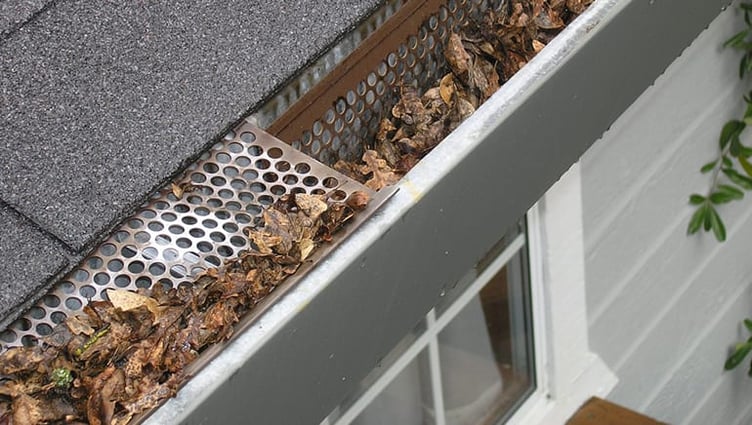
It’s easy to take your gutters for granted when they’re working properly. Gutters prevent water from streaming down your home’s siding and pooling near its foundation. If your gutters don’t guide the rain safely away from your home, however, you could experience a myriad of problems, such as
- Roof leaks
- Siding discoloration
- Ice dams
- Foundation damage
- Flooding in basement or crawlspace
- Landscape erosion
- Mosquitoes (due to standing water)
- Growth of moss, algae, or other vegetation on roof
Tuning your gutters involves clearing, tightening, repairing, sealing, and testing them to ensure they are working properly. Regularly cleaning and tuning your gutters will help protect your home. A trained professional can do this for you, or if you’re comfortable performing the steps involved, you can do it yourself.
What is gutter tuning?
Clean
Before any repairs begin, clean your roof valleys, gutters, and downspouts. Any debris, leaves, or dirt left in these areas can clog your gutter system, so it’s best to have them cleaned at least twice a year to prevent gutter failure.
Test
Once the valleys, gutters, and downspouts are clear, test the gutter system for leaks. Leaks in your gutter system can cause serious damage to your home’s siding, foundation, or structure.
Inspect
After performing the leak test, inspect your gutter system for any loose hangers or brackets. These parts keep your gutters securely attached to your home, so it's important to keep them in good shape. You can also be on the lookout for signs of deterioration in your gutter track like rusting or bending.
Repair
After your gutter system has been thoroughly tested and inspected, make any necessary repairs. An experienced professional can seal any leaks, holes, or cracks as well as make recommendations for any larger repairs that may be needed.
Replace
In some cases, portions of your gutter system may need to be replaced. A benefit of enlisting a professional to tune your gutters is that they can identify any major issues and help you determine how best to address them. If you decide to tune your own gutters, be certain to have them professionally inspected at least once a year.
What Should I Use to Clean My Gutters?
When you clean your gutters, it’s important to have the proper tools to protect both you and your home.
Ladder
Make sure you have (or borrow) a ladder tall enough to reach your roof and stable enough to allow you to work safely. As a precaution, we highly recommend asking someone to hold the ladder for you while you work or using a ladder stabilizer—also known as a stand-off—which mounts on extension ladders.
Working Gloves
Don’t forget your pair of durable working gloves to protect your hands against sharp sticks and other debris. Your gloves should also be waterproof to keep your hands dry and thick enough to keep them warm.
Bucket, Tarp, or Trash Bags
To avoid having to spend considerable time cleaning up your mess afterward, you should have something to keep your yard tidy as you go. You could hang a bucket from your ladder or stuff the debris into durable trash bags. Another option is to lay a tarp on the ground below you to catch anything you drop; sometimes, it’s easier to simply throw what you grab from the gutters to the ground than manage a receptacle on your ladder.
Trowel, Scoop, or Tongs
Any of these tools will help you dig in deep and dislodge debris that’s packed down tight inside your rain gutters. They will also help you pick up the sludge hiding under the pine needles, sticks, and leaves that are harder to grab by hand.
Plumber’s Snake
A plumber’s snake can come in handy when you get to your downspouts, especially if they’re clogged with hard-to-budge debris.
Water Hose
Once you remove as much debris from your gutters as you can, grab a hose with a high-powered spray nozzle to loosen any remaining gunk and wash your gutters clean.
How Often Should I Clean My Gutters?
Most professionals recommend having your gutters cleaned and tuned at least two times a year, in the spring and fall. There are several reasons these are the best times of the year for this task:
- Summer is a prime time for rain, and winter is a prime time for snow; both require your gutters to work properly. By cleaning your gutters in spring and fall, you are helping them protect your home during the wet seasons.
- Cleaning your gutters in fall allows you to get everything out before it freezes, and cleaning your gutters in the spring lets you remove debris that has frozen in your gutters over the winter.
- Cleaning your gutters during the milder months can save you from getting a sunburn or frostbite!
Depending on your surroundings, you may need to conduct maintenance on them more often. Pine trees, in particular, can be a major hazard for your gutter system. If your yard has a lot of trees, you should consider having your gutters cleaned and tuned once a quarter. If you don't feel confident in your ability to safely maintain your gutter system, enlist the help of a local professional for reliable gutter cleaning service.
Damaged or clogged gutters can wreak havoc on your home. Regular maintenance is key to preventing a huge problem. Some homeowners can safely perform gutter maintenance on their own, but it’s important to know your limits. If you’re unsure of your ability to safely and properly tune your gutters, don’t hesitate to contact a professional.
To learn more about how to clean your gutters, subscribe to our blog.
